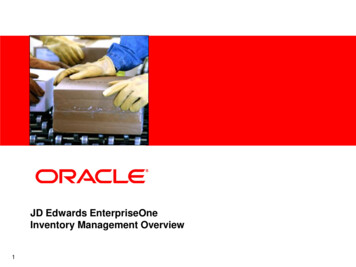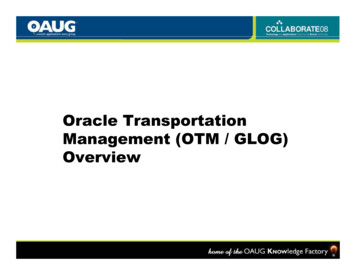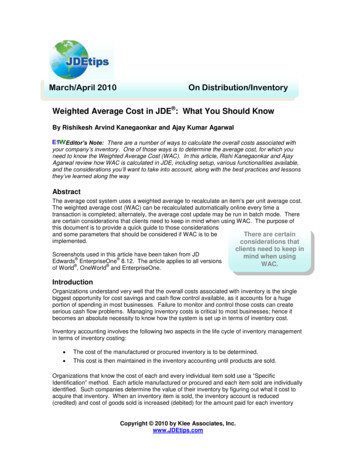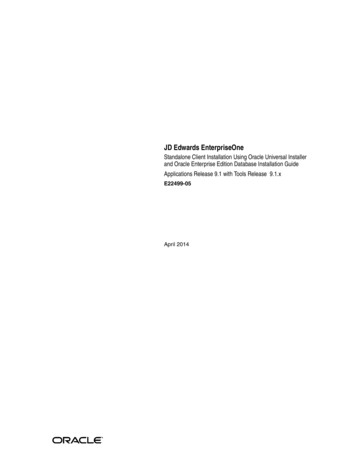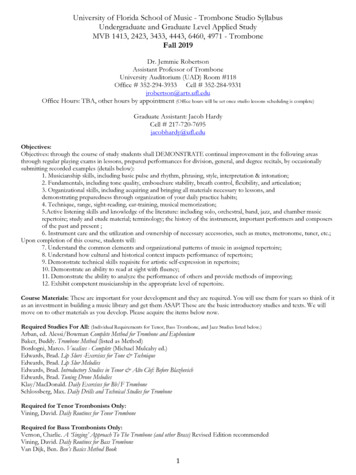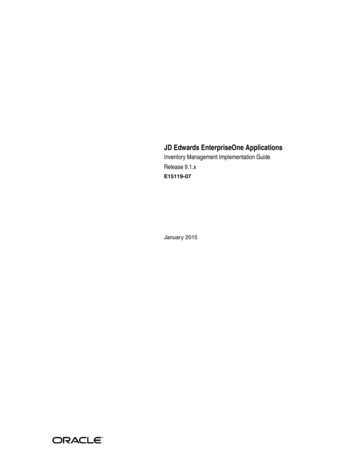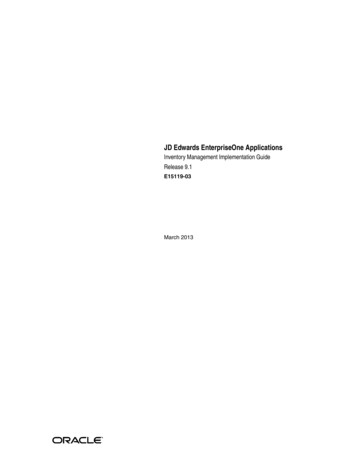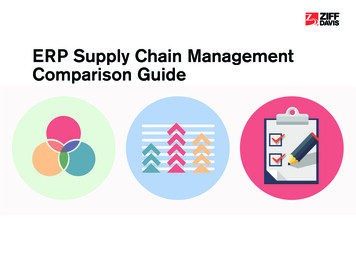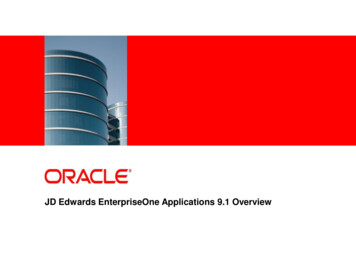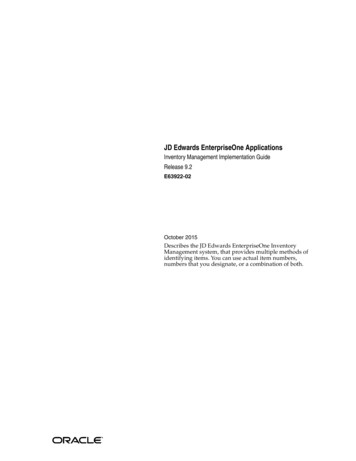
Transcription
[1]JDEdwards EnterpriseOne ApplicationsInventory Management Implementation GuideRelease 9.2E63922-02October 2015Describes the JD Edwards EnterpriseOne InventoryManagement system, that provides multiple methods ofidentifying items. You can use actual item numbers,numbers that you designate, or a combination of both.
JD Edwards EnterpriseOne Applications Inventory Management Implementation Guide, Release 9.2E63922-02Copyright 2014, 2015, Oracle and/or its affiliates. All rights reserved.This software and related documentation are provided under a license agreement containing restrictions onuse and disclosure and are protected by intellectual property laws. Except as expressly permitted in yourlicense agreement or allowed by law, you may not use, copy, reproduce, translate, broadcast, modify, license,transmit, distribute, exhibit, perform, publish, or display any part, in any form, or by any means. Reverseengineering, disassembly, or decompilation of this software, unless required by law for interoperability, isprohibited.The information contained herein is subject to change without notice and is not warranted to be error-free. Ifyou find any errors, please report them to us in writing.If this is software or related documentation that is delivered to the U.S. Government or anyone licensing iton behalf of the U.S. Government, then the following notice is applicable:U.S. GOVERNMENT END USERS: Oracle programs, including any operating system, integrated software,any programs installed on the hardware, and/or documentation, delivered to U.S. Government end usersare "commercial computer software" pursuant to the applicable Federal Acquisition Regulation andagency-specific supplemental regulations. As such, use, duplication, disclosure, modification, andadaptation of the programs, including any operating system, integrated software, any programs installed onthe hardware, and/or documentation, shall be subject to license terms and license restrictions applicable tothe programs. No other rights are granted to the U.S. Government.This software or hardware is developed for general use in a variety of information managementapplications. It is not developed or intended for use in any inherently dangerous applications, includingapplications that may create a risk of personal injury. If you use this software or hardware in dangerousapplications, then you shall be responsible to take all appropriate fail-safe, backup, redundancy, and othermeasures to ensure its safe use. Oracle Corporation and its affiliates disclaim any liability for any damagescaused by use of this software or hardware in dangerous applications.Oracle and Java are registered trademarks of Oracle and/or its affiliates. Other names may be trademarks oftheir respective owners.Intel and Intel Xeon are trademarks or registered trademarks of Intel Corporation. All SPARC trademarksare used under license and are trademarks or registered trademarks of SPARC International, Inc. AMD,Opteron, the AMD logo, and the AMD Opteron logo are trademarks or registered trademarks of AdvancedMicro Devices. UNIX is a registered trademark of The Open Group.This software or hardware and documentation may provide access to or information about content,products, and services from third parties. Oracle Corporation and its affiliates are not responsible for andexpressly disclaim all warranties of any kind with respect to third-party content, products, and servicesunless otherwise set forth in an applicable agreement between you and Oracle. Oracle Corporation and itsaffiliates will not be responsible for any loss, costs, or damages incurred due to your access to or use ofthird-party content, products, or services, except as set forth in an applicable agreement between you andOracle.
ContentsPreface . xixAudience.Documentation Accessibility .JD Edwards EnterpriseOne Application Fundamentals .Related Documents .Conventions .xixxixxixxixxxxx1 Introduction to JD Edwards EnterpriseOne Inventory .41.4.11.5JD Edwards EnterpriseOne Inventory Management Features. 1-1Item Numbering and Description . 1-1Stocking Features . 1-1Item Cross-Referencing. 1-2Item Locations . 1-2Lots. 1-2Physical Warehouses. 1-2Logical Warehouses. 1-2Item Counts . 1-3Item Costs . 1-3Kits and Components. 1-3Supplemental Data . 1-3Container Management . 1-3Item Record Reservations . 1-3Inventory Interoperability . 1-4JD Edwards EnterpriseOne Inventory Management Business Processes . 1-4JD Edwards EnterpriseOne Inventory Management Integrations . 1-5Electronic Data Interchange . 1-8JD Edwards EnterpriseOne Inventory Management Implementation . 1-9Global Implementation Steps. 1-9Business Interface Integration Objects . 1-102 Setting Up the Inventory Management System2.12.22.2.1Understanding System Setup. 2-1Setting Up Constants . 2-3Understanding Constants. 2-3iii
2.2.1.1Branch/Plant ALL . 2-32.2.1.2Accelerated Pricing Resolution Engine . 2-42.2.2Prerequisites . 2-42.2.3Forms Used to Set Up Constants . 2-42.2.4Defining Branch/Plant Constants . 2-62.2.5Defining Batch Control Constants. 2-142.2.6Setting Up ABC Analysis Codes. 2-162.2.7Defining Item Availability. 2-172.2.8Defining System Constants . 2-182.2.9Defining the Location Format . 2-222.2.10Defining Segments for Locations. 2-242.2.10.1Location Segment Specification. 2-252.3Setting Up Warehouse Locations. 2-272.3.1Understanding Warehouse Locations Setup . 2-272.3.2Understanding Multiple Location Entry. 2-282.3.2.1Elements. 2-282.3.2.2Steps. 2-292.3.3Prerequisites . 2-292.3.4Forms Used to Set Up Warehouse Locations . 2-302.3.5Setting Processing Options for Location Master (P4100) . 2-302.3.5.1Display . 2-302.3.6Entering Individual Locations . 2-302.3.7Entering Multiple Locations. 2-322.4Setting Up Default Location Information. 2-332.4.1Understanding Default Location Information Setup . 2-332.4.2Prerequisites . 2-342.4.3Forms Used to Set Up Default Location Information. 2-342.4.4Defining the Default Location and Approval Route Code. 2-352.4.5Assigning Default Print Queues. 2-362.5Setting Up Standard Units of Measure . 2-362.5.1Understanding Standard Units of Measure. 2-362.5.1.1Example: Conversion Factors for Units of Measure. 2-372.5.2Prerequisite . 2-382.5.3Forms Used to Set Up Standard Units of Measure . 2-382.5.4Defining Standard Units of Measure . 2-382.6Setting Up Item Cross-References . 2-392.6.1Understanding Item Cross-Reference Setup . 2-392.6.1.1Cross-References for Promotional Items. 2-412.6.1.2Cross-References for Related Items . 2-422.6.2Prerequisites . 2-422.6.3Forms Used to Set Up Item Cross-References . 2-432.6.4Setting Processing Options for Item Cross Reference (P4104) . 2-442.6.4.1Processing . 2-442.6.5Setting Up Cross-References for Promotional Items . 2-452.6.6Setting Up Price Cross-References for Related Items . 2-472.7Setting Up Messages. 2-492.7.1Understanding Message Setup . 2-49iv
2.7.2Forms Used to Set Up Messages. 2-502.7.3Setting Up Messages . 2-512.7.4Printing Messages on Program Reports . 2-522.7.5Defining Document Type Exceptions . 2-532.8Setting Up Document Type Information. 2-532.8.1Understanding Document Type Information. 2-532.8.2Forms Used to Set Up Document Type Information. 2-552.8.3Setting Up Document Types . 2-552.8.3.1Inventory. 2-562.8.3.2Sales . 2-572.8.3.3Procurement . 2-592.8.3.4S/WM. 2-602.8.3.5Work Order Definition . 2-602.8.3.6Shipping . 2-612.9Setting Up AAIs in Distribution Systems. 2-612.9.1Understanding AAIs in Distribution Systems. 2-612.9.2Understanding AAIs in the JD Edwards EnterpriseOne Inventory ManagementSystem . 2-622.9.3Prerequisites . 2-632.9.4Forms Used to Set Up AAIs in Distribution Systems. 2-642.9.5Setting Processing Options for Distribution AAIs (P40950). 2-642.9.5.1Defaults . 2-652.9.6Set Up AAIs . 2-653 Entering Item Information3.1Understanding Item Information . 3-13.1.1Prerequisites . 3-23.2Entering Item Master Information. 3-33.2.1Understanding Item Master Information. 3-43.2.1.1Item Units of Measure Information . 3-53.2.1.2Dual Unit of Measure. 3-63.2.1.3Classification Codes . 3-93.2.1.4Attachments . 3-103.2.2Understanding Manufacturing Information . 3-103.2.2.1Item Grade and Potency Information. 3-113.2.2.2Blend Management . 3-113.2.2.3Demand Flow . 3-123.2.3Prerequisites . 3-123.2.4Forms Used to Enter Item Master Information . 3-133.2.5Setting Processing Options for Item Master (P4101) . 3-163.2.5.1Defaults . 3-163.2.5.2Process. 3-173.2.5.3Global Update . 3-193.2.5.4Versions. 3-203.2.5.5Interop . 3-213.2.5.6Style . 3-213.2.6Setting Up Item Information . 3-22v
3.2.6.1Basic Item Data .3.2.6.2Additional Info.3.2.6.3Lot Processing .3.2.7Entering Alternate Descriptions .3.2.8Attaching Messages to Items.3.2.9Entering Notes for Items.3.2.10Adding Classification Codes to Items .3.2.10.1Sales Classification Codes .3.2.10.2Purchasing Classification Codes .3.2.10.3Inventory and Transportation Classification Codes .3.2.10.4Warehouse Classification Codes .3.2.11Entering Default Units of Measure for Items .3.2.11.1Weights and Measures.3.2.12Defining Item Unit of Measure Conversions.3.2.13Specifying a Dual Unit of Measure for an Item.3.2.13.1Weights and Measures.3.2.13.2Additional Info.3.2.14Setting Up Search Sequence Using Price Units of Measure .3.2.15Setting Up Manufacturing Information .3.2.15.1Manufacturing Data .3.2.15.2Grade and Potency .3.2.15.3Service/Warranty .3.2.15.4Supply Chain Planning.3.2.15.5Blend Management .3.2.15.6Demand Flow .3.3Entering Branch/Plant Information.3.3.1Understanding Branch/Plant Information .3.3.1.1Item Locations.3.3.1.2Country of Origin .3.3.1.3Blend Management .3.3.2Prerequisites .3.3.3Forms Used to Enter Branch/Plant Information .3.3.4Setting Processing Options for Item Branch Plant (P41026) .3.3.4.1Process.3.3.4.2Versions.3.3.4.3Interop .3.3.5Assigning Items to Branch/Plants .3.3.6Assigning a Primary Location to an Item.3.3.7Assigning a Secondary Location to an Item .3.3.8Entering Classification Codes for Branch/Plants .3.3.9Entering Tax Information .3.3.10Locating Item Sources .3.3.11Entering Item Reorder Quantities .3.3.12Entering Branch/Plant Manufacturing Information .3.3.13Setting Processing Options for Item Branch Duplication (P41015) .3.3.13.1Defaults 1 .3.3.13.2Default 653-653-653-663-673-683-693-703-743-743-74
3.3.13.3Process.3.3.14Duplicating Individual Items for Multiple Branch/plants.3.3.15Reviewing the Item/Branch Dup-Batch Report.3.4Entering Segmented Items.3.4.1Understanding Segmented Items .3.4.2Forms Used to Enter a Segmented Item .3.4.3Creating a Template for Segmented Items.3.4.4Entering Segmented Items .3.5Working with Matrix and Parent Items.3.5.1Understanding Matrix and Parent Items .3.5.2Understanding Matrix Order Entry .3.5.3Prerequisites .3.5.4Forms Used to Work with Matrix and Parent Items .3.5.5Setting Processing Options for Matrix Items (P4101E) .3.5.5.1Versions.3.5.6Reviewing Matrix Items.3.5.7Setting Processing Options for Matrix Order Entry (P41902) .3.5.7.1Display .3.5.8Ordering Matrix Items .3.6Entering Item Cost Information.3.6.1Understanding Item Cost Information .3.6.1.1Item Cost Update.3.6.2Forms Used to Enter Item Cost Information .3.6.3Setting Processing Options for Cost Revisions (P4105) .3.6.3.1Process.3.6.3.2Interop .3.6.3.3Flex Acct.3.6.4Assigning a Cost Level to an Item.3.6.5Assigning a Cost Method and Cost to an Item.3.6.6Entering Manufacturing Setup Cost Information .3.7Entering Sales Price Information .3.7.1Understanding Sales Price Information .3.7.2Forms Used to Enter Sales Price Information.3.7.3Assigning Price Levels and Price List Groups to an Item.3.7.3.1Additional Info.3.7.4Entering Item Prices 93-893-893-893
[1]JD Edwards EnterpriseOne Applications Inventory Management Implementation Guide Release 9.2 E63922-02 October 2015 Describes the JD Edwards EnterpriseOne Inventory Management system, that provides multiple methods of identifying items. You can use actual item numbe
